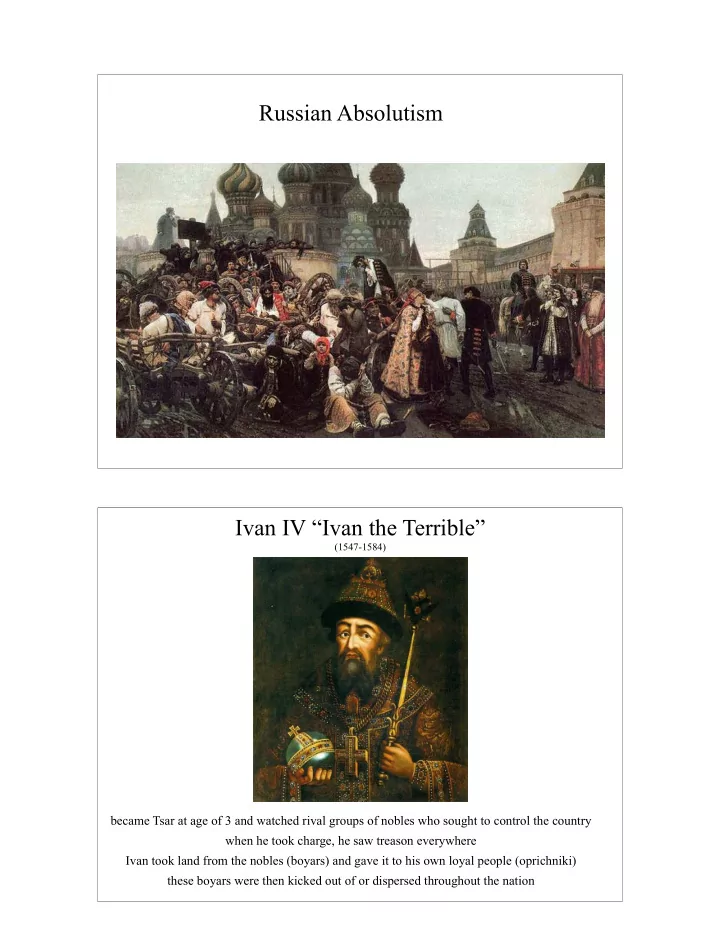

Russian Absolutism Ivan IV “Ivan the Terrible” (1547-1584) became Tsar at age of 3 and watched rival groups of nobles who sought to control the country � when he took charge, he saw treason everywhere � Ivan took land from the nobles (boyars) and gave it to his own loyal people (oprichniki) � these boyars were then kicked out of or dispersed throughout the nation
The Time of Troubles (1598-1613) a time of noble feuds over the throne, peasant revolts, and foreign invasions � Russia suffered a famine from 1601–1603 that killed 1/3rd of the population Michel Romanov (1613-1645) Russia defeated Poland in 1612 � wanted their country to do better � needed a great leader � letters were sent throughout the land � deputies came to Moscow to select the new tsar � the Romanov family were related to former tsars � it was decided that 16 yr-old Michel was the best choice � couldn’t find him [was hiding in a monastery with his mother] � messengers were sent to tell him that he was the new Tsar � [The Romanov dynasty ruled Russia until 1917.] Painting by Grigory Ugryumov of the 16 year-old Mikhail being offered the crown at the Ipatiev Monastery in 1613
Peter the Great The Early Years Tsar Alexis I died in 1676 � his son, the weak and sickly Feodor III took his place � he died in 1682, leaving no heir � a dispute arose over who should inherit the throne � Ivan V, was next in line for the throne [was chronically ill and of “infirm mind”] � the Boyar Duma (Russian nobles council) met � they chose Alexis’ 10 yr-old son Peter to become Tsar [with his mother as regent] his half-sister Sophia was very opposed � she and others insisted that Peter and Ivan be joint Tsars � Sophia acted as regent and exercised all power � she ruled as an autocrat for seven years Peter the Great/Peter I As Acting Regent (1682-1725) forced Russian nobles to adopt Western European ways � sent Russians abroad to learn, esp. shipbuilding, naval warfare, foreign languages, and mathematics � built new capital in St. Petersburg on the Baltic Sea coast it would be more accessible to the West � expanded borders: � took control of Siberia, Alaska, and � the eastern end of Baltic region � changed the Russian government: � created central bureaucracy under his control � brought Eastern Orthodox Church under his authority, ruled by a Holy Synod Fun Fact: Peter the Great was GREAT - very tall (nearly 7 ft)
Peter the Great/Peter I Results of his Reign (1682-1725) economic changes instituted by Peter � created the dvorianie, a new class of feudalistic nobles � given land and control of the serfs on the land � promised to work for the government until death � they didn’t pay taxes - the peasants did � gave incentives to increase production in areas such as mining and metalworking � workers tied to their trade like serfs were to the land � overall effects of his reign: � divided those who wanted to continue old Russian ways and those who adopted Western culture � brought Russia into mainstream European culture Peter the Great on his death bed, 1725, by Nikitin “Catherine the Great”/Catherine II (1762-1796) after Peter’s death in 1725, Russia was ruled by a series of weak rulers � Catherine seized the throne from her weak husband, Peter III � originally thought of freeing serfs � she changed her mind when they revolted against her � freed nobles from their required government service, allowing them to treat their serfs as they wished � when they tried to revolt, she crushed them mercilessly � defeated Ottoman Turks to secure warm-water port of Black Sea and took territory from Poland � was the most renowned and the longest-ruling female leader of Russia � reigned from July 1762 until her death in 1796 at the age of sixty-seven � her reign was called Russia’s Golden Age
Recommend
More recommend